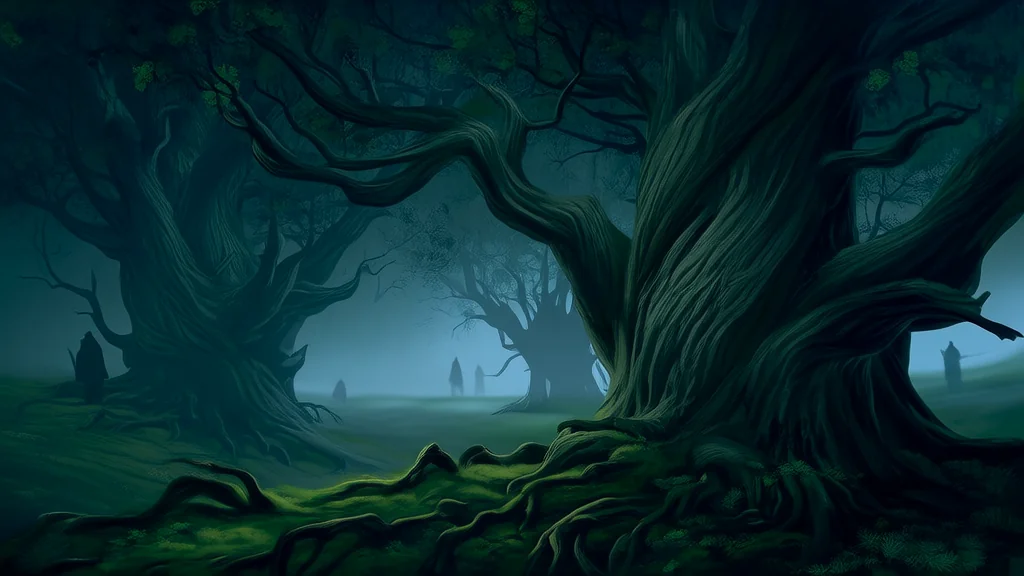🔮 Weird Tales & Urban Legends
The Whispering Woods of Elmsworth and the Unseen Curse That Lurked in the Shadows

In the quiet town of Elmsworth, nestled between rolling hills and thick woods, there was an old legend that no one spoke of openly. It was said that the forest held a curse, one that had been whispered about for generations but never truly believed. The townspeople would cross themselves when passing the edge of the trees, and children were warned not to wander too far from the village. But the curse wasn’t something you could see—it was something you felt.
It began with a man named Elias Vane, a reclusive historian who had moved into the old stone house on the outskirts of town. He claimed he was researching local folklore, but few believed him. Elias spent his days poring over dusty tomes and faded maps, and his nights in the woods, where he insisted he heard strange whispers carried by the wind.
One autumn evening, as the sky turned a deep orange and the air grew sharp with the scent of pine and decay, Elias ventured deeper into the forest than ever before. He followed a narrow path that had long since been swallowed by ivy and moss, its edges marked by stones carved with symbols no one could decipher. The further he went, the more the light seemed to dim, as if the sun itself was reluctant to follow.
At the heart of the clearing stood an ancient tree, its bark twisted and gnarled, its branches stretching like skeletal fingers toward the sky. A small altar lay at its base, covered in lichen and surrounded by broken pottery. Elias knelt, brushing away the dirt with trembling hands, and uncovered a metal ring engraved with the same symbols from the stones. As he lifted it, a chill ran through him, and the air around him seemed to still.
That night, Elias returned to his home, but something had changed. The walls of his house felt colder, and the shadows in the corners moved slightly when he wasn’t looking. His dreams were filled with voices—soft, mournful, and familiar. He couldn’t tell if they were real or just the echoes of his own mind, but they left him restless and sleepless.
Days passed, and the townspeople began to notice Elias’s odd behavior. He no longer spoke to anyone, and when he did, his eyes seemed distant, as if he were seeing something beyond the world they knew. He stopped going out during the day, and when he did, he walked with a strange, deliberate pace, as though following an unseen path.
Then came the first disappearance. A young boy named Tomlin, who had always been curious about the woods, vanished without a trace. His parents searched the forest for hours, calling his name until their voices cracked, but there was no sign of him. The townsfolk whispered that he had wandered too close to the cursed tree, that he had touched the ring, or worse, that he had listened to the whispers.
Elias, however, remained unchanged. He continued his research, writing feverishly in a journal that no one was allowed to see. His once-organized notes became chaotic, filled with frantic scribbles and diagrams of the symbols he had found. He began to speak of things he shouldn’t have known, of ancient rituals and forgotten gods, of a force that had been waiting for someone to awaken it.
One morning, the townspeople found Elias standing at the edge of the forest, his face pale and his eyes wide with something between awe and terror. He didn’t speak, only pointed to the tree, which now seemed to pulse with a faint, greenish glow. When they approached, they found the altar empty, and the ring gone. The ground around it was scorched, as if something had burned there recently.
No one has seen Elias since. Some say he was taken by the forest, others believe he became part of the curse himself. The tree still stands, its branches swaying even when there is no wind, and the whispers still echo in the silence. No one dares to go near it anymore, but sometimes, on certain nights, you can hear the faint sound of a voice calling out—not in anger, not in fear, but in recognition.
And if you listen closely, you might wonder: was the curse ever really meant to be broken? Or was it simply waiting for the right person to find it?
Published on en
🔗
Related Sites
- AI Blog — AI trends and tech news